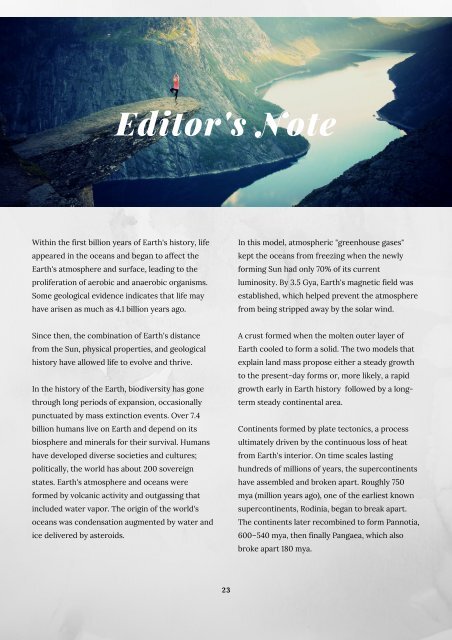You also want an ePaper? Increase the reach of your titles
YUMPU automatically turns print PDFs into web optimized ePapers that Google loves.
Editor's Note<br />
Within the first billion years of Earth's history, life<br />
appeared in the oceans and began to affect the<br />
Earth's atmosphere and surface, leading to the<br />
proliferation of aerobic and anaerobic organisms.<br />
Some geological evidence indicates that life may<br />
have arisen as much as 4.1 billion years ago.<br />
In this model, atmospheric "greenhouse gases"<br />
kept the oceans from freezing when the newly<br />
forming Sun had only 70% of its current<br />
luminosity. By 3.5 Gya, Earth's magnetic field was<br />
established, which helped prevent the atmosphere<br />
from being stripped away by the solar wind.<br />
Since then, the combination of Earth's distance<br />
from the Sun, physical properties, and geological<br />
history have allowed life to e<strong>vol</strong>ve and thrive.<br />
In the history of the Earth, biodiversity has gone<br />
through long periods of expansion, occasionally<br />
punctuated by mass extinction events. Over 7.4<br />
billion humans live on Earth and depend on its<br />
biosphere and minerals for their survival. Humans<br />
have developed diverse societies and cultures;<br />
politically, the world has about 200 sovereign<br />
states. Earth's atmosphere and oceans were<br />
formed by <strong>vol</strong>canic activity and outgassing that<br />
included water vapor. The origin of the world's<br />
oceans was condensation augmented by water and<br />
ice delivered by asteroids.<br />
A crust formed when the molten outer layer of<br />
Earth cooled to form a solid. The two models that<br />
explain land mass propose either a steady growth<br />
to the present-day forms or, more likely, a rapid<br />
growth early in Earth history followed by a longterm<br />
steady continental area.<br />
Continents formed by plate tectonics, a process<br />
ultimately driven by the continuous loss of heat<br />
from Earth's interior. On time scales lasting<br />
hundreds of millions of years, the supercontinents<br />
have assembled and broken apart. Roughly 750<br />
mya (million years ago), one of the earliest known<br />
supercontinents, Rodinia, began to break apart.<br />
The continents later recombined to form Pannotia,<br />
600–540 mya, then finally Pangaea, which also<br />
broke apart 180 mya.<br />
23


